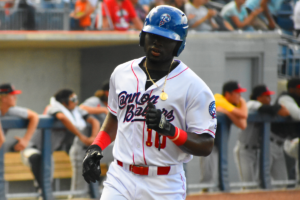Despite down season, Luis Gonzalez remains intriguing
Luis Gonzalez has, from the moment he was drafted, been one of the more trendy prospect sleeper picks. Coming out of New Mexico, and having played in a Mountain West Conference not exactly known as a hotbed for baseball talent, Gonzalez flew somewhat under the radar as a college prospect.
Perhaps surprisingly, the White Sox scooped him up in the third round of the 2017 draft. After a productive 2018, in which the center fielder slugged 14 home runs and 40 doubles in 482 at-bats split between Kannapolis and Winston-Salem, Gonzalez received the expected promotion to Birmingham to kick off 2019.
A full season with the Barons later, Gonzalez’ stock appears to be down.
A slight regression was, perhaps, to be expected, but Gonzalez’ offensive production plummeted in the Southern League. While he received almost the same amount of at-bats as the year before (473), the former Lobo only hit 9 homeruns and 18 doubles; substantial downgrades from his time in A and A+. His OPS dropped almost 200 points, from .866 to .675, mostly courtesy of a 150-point drop in SLG.
WHAT HAPPENED?
Based on some stats and graphs, it appears Gonzalez simply started selling out for homeruns. His GO/AO (groundout-to-air-out) dropped from 1.12 in 2018 to 1.01 in 2019, meaning: in 2018 he hit more balls on the ground then in 2019. This past season, he hit almost one flyball for every groundball, meaning his flyball rate increased.
In itself, that is not a bad development; fly balls can, after all, lead to home runs. For Gonzalez, however, it was detrimental to his overall approach at the plate. It appears the 24-year old started pulling pitches to right field excessively, losing his opposite field stroke in the process.
This development is visible in his spray charts below.

PULLING PITCHES
In 2018, Gonzalez filled the middle and opposite side of the field with doubles. No fewer than 15 of his 40 doubles (or 37%) were of the opposite field variety (Gonzalez hits left-handed). Though most of his home run power still consisted of pitches pulled to right field, it was the complete disappearing of (power in) his opposite field swing in 2019 that led to the dramatic decrease in production.
The number of weakly-hit singles to left field increased. The number of hard-hit doubles — and the occasional home run — to that part of the ballpark decreased or disappeared completely. Granted, almost 50% of his doubles in 2019 were still to hit to the opposite field, but the alteration of his approach in order to pull the ball more led to a 55% overall drop in doubles to begin with.
On top of the lack in doubles and home runs, Luis Gonzalez increased his overall weak-contact rate. In 2018, only 7 of his hits stayed on the infield grass (five of which were bunt singles). A season later, the number of hits that did not leave the infield jumped to 22. Aside from the fact that Gonzalez showed impressive speed more often, beating out infield hits, it also showed he went away from his line-drive-to-all-fields approach, and more often had to rely on his speed to bail him out of trouble.
Note that Gonzalez attempted a bunt 14 times in 2019, nine of which went for hits and therefore showed up in the charts above. That leaves 13 base hits hit so softly that they did not leave the grass; over six times the total amount of 2018.
THE WAY BACK UP
Later on in the season, one of two things happened. Either Gonzalez went back to what worked before, or the season-long efforts to change his swing started to bear fruit. His final full month of the season was Gonzalez’ best, by a mile.
After hitting no higher than .253/.333/.391 (combined), the outfielder broke out in August: .280/.370/.398. His .768 OPS beat his previous monthly season-high by 50 points. He walked the most of any month (14), struck out the least (15), and even threw in 7 stolen bases in the process, besting his previous monthly high by 4. Gonzalez also struck out less over a full season in Birmingham (89 times) than he did in Kannapolis and Winston-Salem combined (103); all that in spite of a seemingly more power-oriented approach.
Clearly, despite the drop in overall production in 2019, there is hope for the talented outfielder. For Gonzalez and the Sox’ sake, one can only hope the late-season surge indicated a return to normalcy. If it did, 2020 could prove to be the breakout year everybody hoped 2019 was going to be.
Want to know right away when we publish a new article? Type your email address in the box on the right-side bar (or at the bottom, if on a mobile device) and click the “Subscribe” button. Our list is completely spam free, and you can opt out at any time. Also, consider supporting FutureSox on Patreon! You can get early access to special articles and Patreon-only posts, in addition to more benefits you can read about here.








There is a lot of white space on this site. I would prefer a lightly colored background. Overall I think this is a great site. The new content is really in-depth like your series Prospects by Position. Has anyone seen Burger yet? I wonder if he gained a lot of weight during 2 years of not playing?
Great post! I was really excited about this guy after 2018. I’m a sucker for a doubles-to-all-fields batting style and hadn’t realized until now that his approach had been somewhat different in 2019. Hopefully he was working to integrate some White Sox coaching tips last year and it will all come together in 2020.
I’m scared by all those infield singles, though. That means his 2019 batting results were even less impressive than they looked…